Truth 20. Negotiate issues simultaneously, not sequentially
Many people negotiate in the same way that they run their business meetings: by strict agenda. They simply list all issues under negotiation and then attempt to reach an agreement on each one, in sequence. Unfortunately, negotiating each issue independently is not only exhausting, it increases the likelihood of lose–lose agreements. Why? Negotiators are more likely to adopt a demanding, positional approach on each issue; they fight each battle and lose perspective about what is ultimately the most important issue. A far better approach is to discuss issues as packages and combine issues.
The key for negotiators is to handle several parts of a deal at the same time. This approach has several advantages. First, it prevents negotiators from being completely positional. Second, it forces them to prioritize their values and preferences across several issues. Third, it may spark the brilliant idea of considering packages or combinations of agreement terms.
The key for negotiators is to handle several parts of a deal at the same time.
Consider a case of two negotiators discussing three issues in a sales deal: price, volume, and delivery. Ms. Buyer wants a low price, low volume, and fast delivery. Mr. Seller wants a high price, high volume, and slow delivery. On the surface, their interests seem completely opposed. In other words, it looks like a fixed-sum negotiation.
Now imagine that Ms. Buyer has carefully laid out the priority she gives each issue by splitting 100 points among them: 50 points for price, 35 for delivery, and 15 for volume (see the following buyer table).
As the seller table reveals, Mr. Seller’s values for the three negotiation issues are a little different: Price is also his most important issue (50 points), but volume is second (35 points) and delivery last (15 points).
We also see that Ms. Buyer ideally wants lowest price, lowest volume, and fastest delivery. If that happened, based on the table, she would get 20 + 5 + 15 = 40 points. That represents the buyer’s desired objective.
Let’s suppose these parties decide to negotiate each issue separately. Remember that in the real world, they wouldn’t know each other’s preferences. Here’s how the negotiation might go:
Buyer: It has been a real pleasure to learn about your product. But I have to be honest with you: We are price restricted. We absolutely need your lowest price.
Seller: Well, we have a great-quality, unique product. So we deserve a high price.
Buyer: Then we might not have a deal.
(One hour passes.)
Buyer: We seem to be at two extremes on price. How about we just meet in the middle?
Seller: I guess we can live with that.
Buyer: Okay, then let’s talk about volume. We want to minimize our commitment here, so we need only a small lot of your product.
Seller: Unfortunately, we’re designed to sell big lots. But you’ll definitely love our product, so you’re better off with a bigger volume, anyway.
Buyer: I’m not authorized to approve that.
Seller: Well, the price we talked about is based on a high-volume purchase.
(Another hour passes.)
Seller: There is no way I can go with that volume. I might be able to meet you in the middle, though.
Buyer: That would work.
Seller: Let’s talk about delivery. We can offer our standard terms.
Buyer: No, we need this ASAP!
Seller: Sorry. Our policy clearly states that our standard delivery is several weeks.
Buyer: That just won’t work. I’m being way too generous, but can we meet in the middle again?
Seller: I’ll probably lose my job, but in the spirit of closing this deal...okay.
The buyer and seller would each make a total of 19 points on this deal (buyer gets the sum of medium price = 10; medium volume = 3; medium delivery = 6; and seller gets 10+6+3).
Had they negotiated the issues as a package, they might have realized that volume was relatively more important to Mr. Seller, whereas delivery speed was more important for Ms. Buyer.
That could have led to the following conversation:
Buyer: I see several moving parts to this deal: price, volume, and delivery. We care about all these issues, but price is most important. And we need to get to market fast, so we also care a lot about delivery.
Seller: We need a reasonable price, so I definitely can’t concede too much on price. But my company cares a lot about volume, so we can give better prices with bigger lots. We might be able to work with you on delivery.
Buyer: Would you be willing to give me the fast delivery I need if I buy a greater volume?

